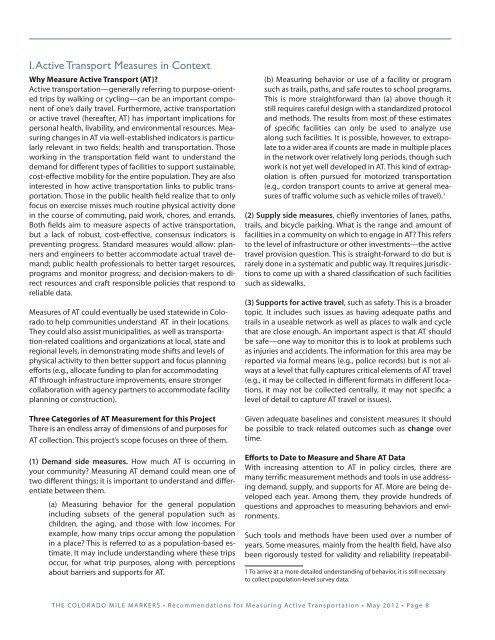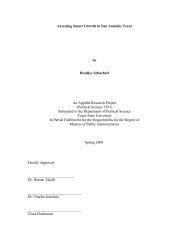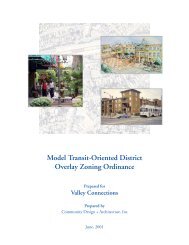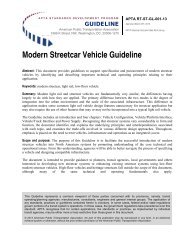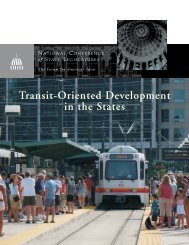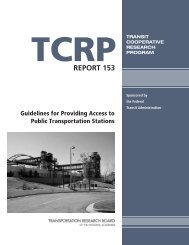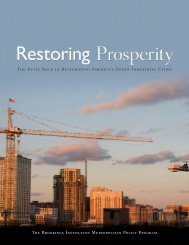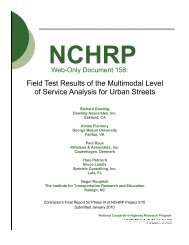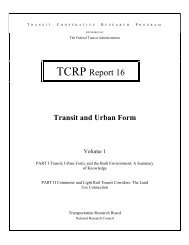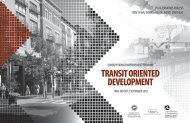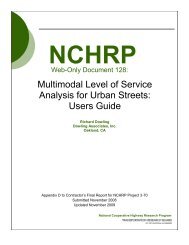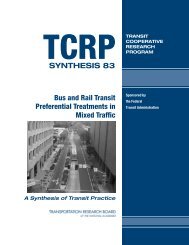the colorado mile markers: recommendations for measuring ...
the colorado mile markers: recommendations for measuring ...
the colorado mile markers: recommendations for measuring ...
Create successful ePaper yourself
Turn your PDF publications into a flip-book with our unique Google optimized e-Paper software.
I. Active Transport Measures in Context<br />
Why Measure Active Transport (AT)<br />
Active transportation—generally referring to purpose-oriented<br />
trips by walking or cycling—can be an important component<br />
of one’s daily travel. Fur<strong>the</strong>rmore, active transportation<br />
or active travel (hereafter, AT) has important implications <strong>for</strong><br />
personal health, livability, and environmental resources. Measuring<br />
changes in AT via well-established indicators is particularly<br />
relevant in two fields: health and transportation. Those<br />
working in <strong>the</strong> transportation field want to understand <strong>the</strong><br />
demand <strong>for</strong> different types of facilities to support sustainable,<br />
cost-effective mobility <strong>for</strong> <strong>the</strong> entire population. They are also<br />
interested in how active transportation links to public transportation.<br />
Those in <strong>the</strong> public health field realize that to only<br />
focus on exercise misses much routine physical activity done<br />
in <strong>the</strong> course of commuting, paid work, chores, and errands.<br />
Both fields aim to measure aspects of active transportation,<br />
but a lack of robust, cost-effective, consensus indicators is<br />
preventing progress. Standard measures would allow: planners<br />
and engineers to better accommodate actual travel demand;<br />
public health professionals to better target resources,<br />
programs and monitor progress; and decision-makers to direct<br />
resources and craft responsible policies that respond to<br />
reliable data.<br />
Measures of AT could eventually be used statewide in Colorado<br />
to help communities understand AT in <strong>the</strong>ir locations.<br />
They could also assist municipalities, as well as transportation-related<br />
coalitions and organizations at local, state and<br />
regional levels, in demonstrating mode shifts and levels of<br />
physical activity to <strong>the</strong>n better support and focus planning<br />
ef<strong>for</strong>ts (e.g., allocate funding to plan <strong>for</strong> accommodating<br />
AT through infrastructure improvements, ensure stronger<br />
collaboration with agency partners to accommodate facility<br />
planning or construction).<br />
Three Categories of AT Measurement <strong>for</strong> this Project<br />
There is an endless array of dimensions of and purposes <strong>for</strong><br />
AT collection. This project’s scope focuses on three of <strong>the</strong>m.<br />
(1) Demand side measures. How much AT is occurring in<br />
your community Measuring AT demand could mean one of<br />
two different things; it is important to understand and differentiate<br />
between <strong>the</strong>m.<br />
(a) Measuring behavior <strong>for</strong> <strong>the</strong> general population<br />
including subsets of <strong>the</strong> general population such as<br />
children, <strong>the</strong> aging, and those with low incomes. For<br />
example, how many trips occur among <strong>the</strong> population<br />
in a place This is referred to as a population-based estimate.<br />
It may include understanding where <strong>the</strong>se trips<br />
occur, <strong>for</strong> what trip purposes, along with perceptions<br />
about barriers and supports <strong>for</strong> AT.<br />
(b) Measuring behavior or use of a facility or program<br />
such as trails, paths, and safe routes to school programs.<br />
This is more straight<strong>for</strong>ward than (a) above though it<br />
still requires careful design with a standardized protocol<br />
and methods. The results from most of <strong>the</strong>se estimates<br />
of specific facilities can only be used to analyze use<br />
along such facilities. It is possible, however, to extrapolate<br />
to a wider area if counts are made in multiple places<br />
in <strong>the</strong> network over relatively long periods, though such<br />
work is not yet well developed in AT. This kind of extrapolation<br />
is often pursued <strong>for</strong> motorized transportation<br />
(e.g., cordon transport counts to arrive at general measures<br />
of traffic volume such as vehicle <strong>mile</strong>s of travel). 1<br />
(2) Supply side measures, chiefly inventories of lanes, paths,<br />
trails, and bicycle parking. What is <strong>the</strong> range and amount of<br />
facilities in a community on which to engage in AT This refers<br />
to <strong>the</strong> level of infrastructure or o<strong>the</strong>r investments—<strong>the</strong> active<br />
travel provision question. This is straight-<strong>for</strong>ward to do but is<br />
rarely done in a systematic and public way. It requires jurisdictions<br />
to come up with a shared classification of such facilities<br />
such as sidewalks.<br />
(3) Supports <strong>for</strong> active travel, such as safety. This is a broader<br />
topic. It includes such issues as having adequate paths and<br />
trails in a useable network as well as places to walk and cycle<br />
that are close enough. An important aspect is that AT should<br />
be safe—one way to monitor this is to look at problems such<br />
as injuries and accidents. The in<strong>for</strong>mation <strong>for</strong> this area may be<br />
reported via <strong>for</strong>mal means (e.g., police records) but is not always<br />
at a level that fully captures critical elements of AT travel<br />
(e.g., it may be collected in different <strong>for</strong>mats in different locations,<br />
it may not be collected centrally, it may not specific a<br />
level of detail to capture AT travel or issues).<br />
Given adequate baselines and consistent measures it should<br />
be possible to track related outcomes such as change over<br />
time.<br />
Ef<strong>for</strong>ts to Date to Measure and Share AT Data<br />
With increasing attention to AT in policy circles, <strong>the</strong>re are<br />
many terrific measurement methods and tools in use addressing<br />
demand, supply, and supports <strong>for</strong> AT. More are being developed<br />
each year. Among <strong>the</strong>m, <strong>the</strong>y provide hundreds of<br />
questions and approaches to <strong>measuring</strong> behaviors and environments.<br />
Such tools and methods have been used over a number of<br />
years. Some measures, mainly from <strong>the</strong> health field, have also<br />
been rigorously tested <strong>for</strong> validity and reliability (repeatabil-<br />
1 To arrive at a more detailed understanding of behavior, it is still necessary<br />
to collect population-level survey data.<br />
The Colorado Mile Markers • Recommendations <strong>for</strong> Measuring Active Transportation • May 2012 • Page 8


